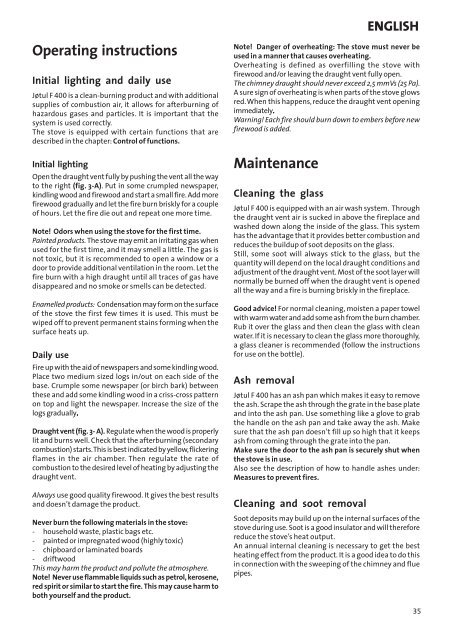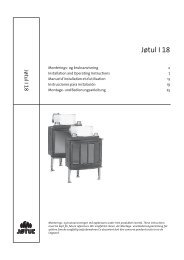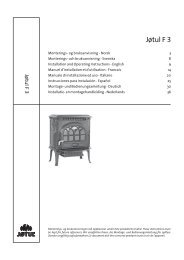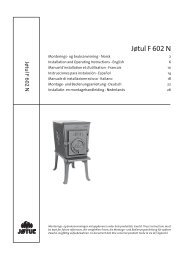Create successful ePaper yourself
Turn your PDF publications into a flip-book with our unique Google optimized e-Paper software.
ENGLISHOperating instructionsInitial lighting and daily useJøtul F 400 is a clean-burning product and with additionalsupplies of combustion air, it allows for afterburning ofhazardous gases and particles. It is important that thesystem is used correctly.The stove is equipped with certain functions that aredescribed in the chapter: Control of functions.Initial lightingOpen the draught vent fully by pushing the vent all the wayto the right (fig. 3-A). Put in some crumpled newspaper,kindling wood and firewood and start a small fire. Add morefirewood gradually and let the fire burn briskly for a coupleof hours. Let the fire die out and repeat one more time.Note! Odors when using the stove for the first time.Painted products. The stove may emit an irritating gas whenused for the first time, and it may smell a little. The gas isnot toxic, but it is recommended to open a window or adoor to provide additional ventilation in the room. Let thefire burn with a high draught until all traces of gas havedisappeared and no smoke or smells can be detected.Enamelled products: Condensation may form on the surfaceof the stove the first few times it is used. This must bewiped off to prevent permanent stains forming when thesurface heats up.Daily useFire up with the aid of newspapers and some kindling wood.Place two medium sized logs in/out on each side of thebase. Crumple some newspaper (or birch bark) betweenthese and add some kindling wood in a criss-cross patternon top and light the newspaper. Increase the size of thelogs gradually.Draught vent (fig. 3- A). Regulate when the wood is properlylit and burns well. Check that the afterburning (secondarycombustion) starts. This is best indicated by yellow, flickeringflames in the air chamber. Then regulate the rate ofcombustion to the desired level of heating by adjusting thedraught vent.Always use good quality firewood. It gives the best resultsand doesn’t damage the product.Never burn the following materials in the stove:- household waste, plastic bags etc.- painted or impregnated wood (highly toxic)- chipboard or laminated boards- driftwoodThis may harm the product and pollute the atmosphere.Note! Never use flammable liquids such as petrol, kerosene,red spirit or similar to start the fire. This may cause harm toboth yourself and the product.Note! Danger of overheating: The stove must never beused in a manner that causes overheating.Overheating is defined as overfilling the stove withfirewood and/or leaving the draught vent fully open.The chimney draught should never exceed 2,5 mmVs (25 Pa).A sure sign of overheating is when parts of the stove glowsred. When this happens, reduce the draught vent openingimmediately.Warning! Each fire should burn down to embers before newfirewood is added.MaintenanceCleaning the glassJøtul F 400 is equipped with an air wash system. Throughthe draught vent air is sucked in above the fireplace andwashed down along the inside of the glass. This systemhas the advantage that it provides better combustion andreduces the buildup of soot deposits on the glass.Still, some soot will always stick to the glass, but thequantity will depend on the local draught conditions andadjustment of the draught vent. Most of the soot layer willnormally be burned off when the draught vent is openedall the way and a fire is burning briskly in the fireplace.Good advice! For normal cleaning, moisten a paper towelwith warm water and add some ash from the burn chamber.Rub it over the glass and then clean the glass with cleanwater. If it is necessary to clean the glass more thoroughly,a glass cleaner is recommended (follow the instructionsfor use on the bottle).Ash removalJøtul F 400 has an ash pan which makes it easy to removethe ash. Scrape the ash through the grate in the base plateand into the ash pan. Use something like a glove to grabthe handle on the ash pan and take away the ash. Makesure that the ash pan doesn’t fill up so high that it keepsash from coming through the grate into the pan.Make sure the door to the ash pan is securely shut whenthe stove is in use.Also see the description of how to handle ashes under:Measures to prevent fires.Cleaning and soot removalSoot deposits may build up on the internal surfaces of thestove during use. Soot is a good insulator and will thereforereduce the stove’s heat output.An annual internal cleaning is necessary to get the bestheating effect from the product. It is a good idea to do thisin connection with the sweeping of the chimney and fluepipes.35






